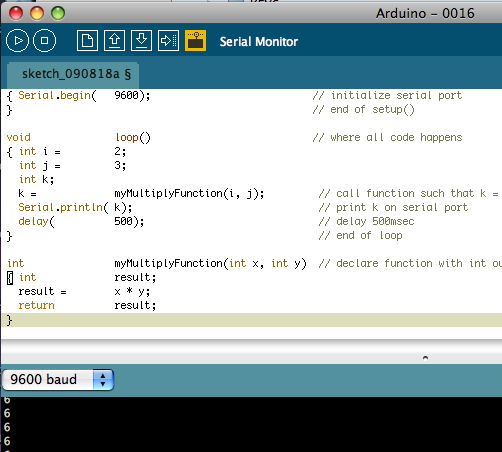Arduino Serial Function
I have a library for Meshnetics Zibee modules that works fine for the standard Arduino. However, the standard Arduino only has one hardware serial port. I want to use this library on and Arduino Mega which has four ports to choose from. I attach below a small snippet of the library. Calling a Function in an Arduino Sketch. To call a function, use the function name followed by opening and closing parentheses. Finally terminate the statement that calls the function with a semicolon. Load the sketch to an Arduino and then open the terminal window. The sketch prints some text in a box as shown below. The function gets defined outside of any of the other functions in the code in a similar way to the setup and loop functions. The basic structure is: Arduino Void Method. Notice the use of the equals function. This is a function in the Arduino String class which returns true if the string in question is equal to the parameter string. Serial inputs can be very useful in your Arduino project. It’s a bit more complex than serial output, but not by much! The key functions are Serial.available and Serial.read. The Arduino Reference text is licensed under a Creative Commons Attribution-Share Alike 3.0 License. Find anything that can be improved? Suggest corrections and new documentation via GitHub. Doubts on how to use Github? Learn everything you need to know in this tutorial. Open the Serial monitor in the Arduino IDE (Ctrl+Shift+M). Ensure that you have set the baud rate in the Serial monitor to 9600. You should see the following output: The sprintf function requires that you have a character array to store the output.
- Arduino Tutorial
- Arduino Function Libraries
- Arduino Advanced
- Arduino Projects
- Arduino Sensors
- Motor Control
- Arduino And Sound
- Arduino Useful Resources
- Selected Reading
Functions allow structuring the programs in segments of code to perform individual tasks. The typical case for creating a function is when one needs to perform the same action multiple times in a program.
Standardizing code fragments into functions has several advantages −
Functions help the programmer stay organized. Often this helps to conceptualize the program.
Functions codify one action in one place so that the function only has to be thought about and debugged once.
This also reduces chances for errors in modification, if the code needs to be changed.
Functions make the whole sketch smaller and more compact because sections of code are reused many times.
Enrique iglesias bailando songs download free mp3. This application is a mp3 streaming app that contains songs from the latest and complete Enrique Iglesias For You.
They make it easier to reuse code in other programs by making it modular, and using functions often makes the code more readable.
There are two required functions in an Arduino sketch or a program i.e. setup () and loop(). Other functions must be created outside the brackets of these two functions.
The most common syntax to define a function is −
Arduino Programming Manual Pdf
Function Declaration
A function is declared outside any other functions, above or below the loop function.
We can declare the function in two different ways −
The first way is just writing the part of the function called a function prototype above the loop function, which consists of −
- Function return type
- Function name
- Function argument type, no need to write the argument name
Function prototype must be followed by a semicolon ( ; ).
The following example shows the demonstration of the function declaration using the first method.
Example
The second part, which is called the function definition or declaration, must be declared below the loop function, which consists of −
Poptropica, a virtual world for kids to travel, play games, compete in head-to-head competition, and communicate safely. Kids can also read books, comics, and see movie clips while they play. Poptropica for free games.
- Function return type
- Function name
- Function argument type, here you must add the argument name
- The function body (statements inside the function executing when the function is called)
The following example demonstrates the declaration of function using the second method.

Arduino Serial.available Function
Example
Arduino Functions List
The second method just declares the function above the loop function.